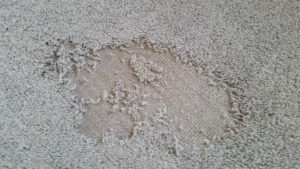Beetles
Carpet Beetles
Description
Carpet beetles feed on a wide range of animal-based items, including silk, leather, fur, wool and animal hair. As a result, carpet beetles may infest carpets, upholstered furniture, blankets, coats, comforters, wool, pillows and clothing. While carpet beetles rarely attack synthetic fabrics, they may feed on these items when they are soiled by perspiration, oil and food. Infestations can spread quickly.
Adult carpet beetles feed on pollen and nectar outdoors. The larvae may eat seeds, animal food and other milled products in the pantry or kitchen. Although adult carpet beetles can thrive inside or outside, females prefer to lay eggs where larval food sources are abundant. Carpet beetles enter homes through doors, windows and other openings, although they may be brought in on cut plants and flowers, as well. Some carpet beetles make their homes inside the nests of birds or other animals and can live in walls or chimneys, feeding on dead insects and animals.
Both adults and larvae prefer to feed in dark, undisturbed areas. As a result, identification of an infestation can prove difficult. Because an infestation can go unnoticed until it is widespread, treatment is best left to pest control professionals. Contact your local expert for extermination options.
Damage
Immature carpet beetles, called larvae, cause damage to human clothing, furnishings, and other products. These larvae feed on natural fibers, while adults feed primarily on plant nectar and pollen. Larvae scavenge for food in dark and hidden areas. Infestations occur swiftly and often go unnoticed until damage is widespread.
The larvae of carpet beetles feed primarily on animal and plant materials such as fur, dander, silk, wool and feathers. As a result, they damage clothing, furniture and other household materials. While larvae prefer organic materials, they will consume synthetic fibers with oil, perspiration and food stains. They sometimes feed on grains and spices, as well as nuts, cereals and other milled products. Larvae may also consume animal hair, dead animals and insects.
Larvae can be found living under floors, behind baseboards, inside air ducts, under heavy furniture and in other hidden areas. Although carpet beetle larvae move slowly, they infest entire homes and cause considerable damage within weeks.
Adult carpet beetles feed on plant-based foods outside and can be found scavenging in gardens, where they cause damage to ornamental flora with light petals. While adult carpet beetles do not cause damage to fiber, they are also considered indoor pests.
Management
It is important to properly identify the pest to ensure the correct treatment method is followed. Once proper identification has been established, proper preparation may be required before a scheduled treatment can be performed. We can help you with each step of the process from idenfying the problem to chosing the correct method of treatment.
Spider Beetles
Description
The shiny spider beetle (Mezium affine) is a pest of stored food products. It gets its name from the fact that the adult beetle resembles a small spider. The wing covers give it a “humped” appearance. It is a small insect. Adults range in size from 1.5 to 3.5 mm.
The shiny spider beetle is solid colored. The color varies from dark red to black.
This beetle is often confused with the American spider beetle, which has cream-colored head and legs. There are several other species of spider beetles, including the Australian, the golden and the whitemarked.
The shiny spider beetle feeds on moldy food and food products. It also feeds on products that have been stored a very long time and are out of condition for use by people. Shiny spider beetles have infested houses, hotels, warehouses and bakeries. They feed on cereal, pet food, stored seeds, woolens, animal droppings and paper.
Shiny spider beetles have also been found in bird nests and rat nests. When the nests are in attics or crawl spaces, the beetles can easily move into the living space.
Damage and Control
Shiny spider beetles ruin more food with their webbing and their droppings than they actually eat. Webbing on food and holes in packages is a sign that shiny spider beetles may be active.
Inspection and cleaning are the key steps in eliminating shiny spider beetles. It is important to find everything that they have infested. Empty pantry and cabinet shelves. Inspect every package and throw away any that are infested. Vacuum the empty shelves. This will remove any food residue. Store new food products in sealed glass or plastic containers.
Insecticide application is the final step. Apply it into the cracks and crevices at the back and sides of the shelves. Treat cracks and crevices in any other areas where the beetles have been active. The object is to eliminate any insects that might be hiding. To avoid misapplication, it is often preferable to call the local pest control professional.
MORE INFORMATION

Carpet beetle treatment preparation sheet download »
SPECIAL PREPARATION MAY BE NECESSARY BEFORE A SCHEDULED TREATMENT CAN BE PERFORMED. IF IT HAS BEEN DETERMINED THAT YOU NEED TO PREPARE YOUR LIVING AREA, PLEASE DOWNLOAD OUR PREPARATION SHEET.
✓ Certified Technicians
✓ Extensive Industry Training
✓ Established in 1896
✓ Inspections
✓ Environmentally Conscious
✓ Full-Service Solutions
✓ FREE Consultations
✓ Maintenance Programs
✓ Rodent Exclusion
✓ Bed Bug Canine Inspections
✓ Guaranteed Satisfaction
✓ Emergency Service

